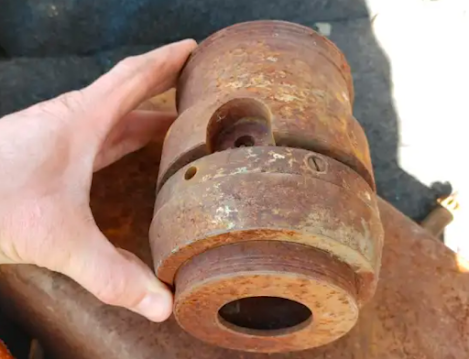I wont go into detail about the second time I moved the lathe, this time from Milton Ontario to Pickering Ontario, because I didn't take any pics and that all went smoothly except....
Let's just say that picking up 1250 pound machine by the bare metal of the base, with bare metal forks requires care and attention. The lack of friction will permit a machine to slide right off the forks if the tractor or skid steer you are using departs from level in any of three directions. Twelve hundred pounds of machine will kill or maim anyone it hits.
So we spread out the forks to provide a wider base, and used load binders to fasten the lathe to the tractor during the lift. Pro-tip, remove the load binders before trying to back your loader away from your trailer to avoid embarrassment if there are any onlookers.
Given the long day we left the lathe on the pallet ready to lift the next day with our gantry crane and electric hoist.
With the lathe finally in our own shop I could begin to systematically tear down and clean portions of the lathe to catalogue what is missing and what essential parts must be replaced with OEM parts in order to meet my standards for a quality restoration.
Where original parts are no longer available I'll try to machine new parts to the original specifications, but I may make minor changes to improve functionality and durability.
I could easily see that the finish is pretty poor. With worn, cracking, and peeling paint. The ways and lead screw looked okay visually, but a light surface rust has formed in a couple non-critical places on the cross slide.
I found that the lathe had no oil in either the head stock, variator or the gear box. The oil levels in the apron remain a mystery for now.
I purchased 5 liters of Morlina 10 for the variator and headstock from Variate Ltd in Toronto, Ontario, Canada. I could not find a local supplier of ISO Tellus 68 oil for the gear box, or rather I haven't heard back from the company Shell referred me to, so I will just use an equivalent sold by Canadian Tire; Certified AW68 Anti-Wear Hydraulic Oil, it's about $100 for 18.9 liters, or $40 for 5 liters.
But before tackling the head stock, gear box and variator I wanted to assess the easier items first, so onto assessing the accessories first.
What was at first excitement at seeing a KC15 collet chuck quickly turned to disappointment when I found that the chuck was missing the front cap required to retain the collets and that there were only two collets out of what should be a set of 12. At least there are two chuck keys.
Initially I was not sure were Burnerd Multisize collets, because I couldn't read the manufacturer's name on them. It required a quick trip to the ultrasonic cleaner to reveal those details.
So far things are not looking all that great from a standpoint of completeness, which means I'd need to spend a lot to make this chuck whole. According to Colchester the cost of a cap is £286 plus carriage of £15 to be precise. That's just to be able to use 2 collets. Optionally, I can make a cap, and for less than the price of a new cap.
Thanks to a few helpful people from the Colchester Lathe group I was able to obtain the dimensions of the missing front cap. Along with a few good photos of a complete ER Collet chuck and cap.
That much money could pay for new front bearings if necessary.

























.jpg)


No comments:
Post a Comment